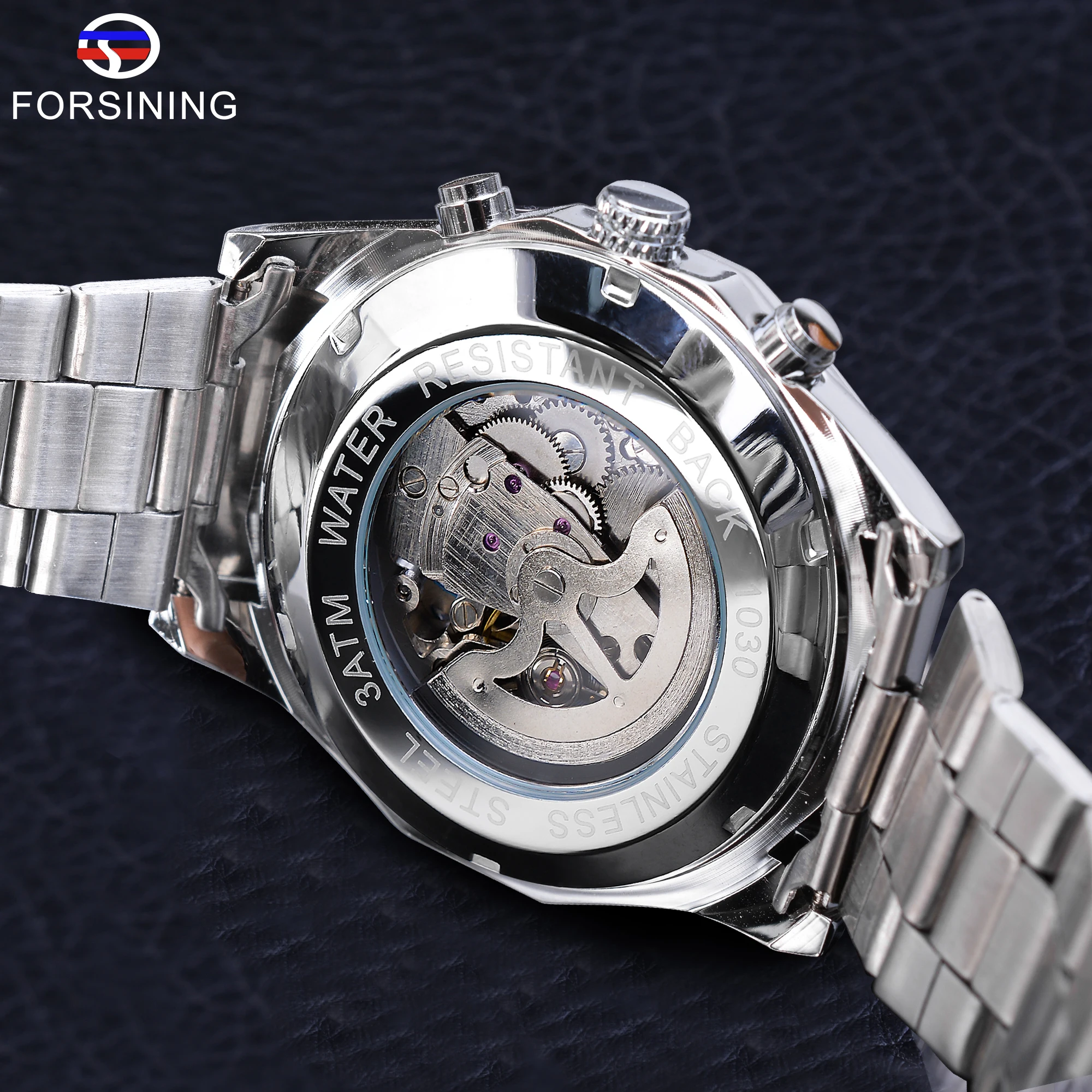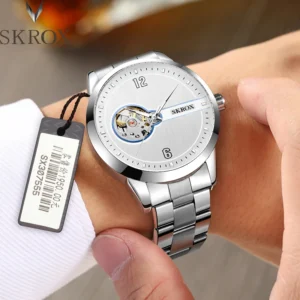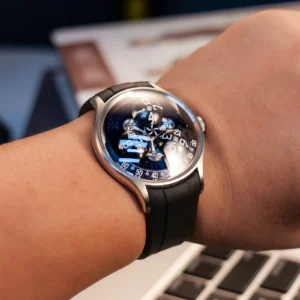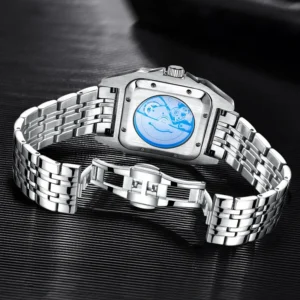Unveiling the Skeleton Watch: Transparency By Design
Skeleton watches represent the perfect marriage between technical mastery and artistic expression in the world of horology. Unlike conventional timepieces that conceal their inner workings, these remarkable creations deliberately expose their mechanical hearts through the strategic removal of material from the movement plates and bridges.
At their core, skeleton watches are timepieces specifically engineered to display their inner mechanisms. The defining characteristic lies in the deliberate reduction of metal components to their essential minimum—creating an intricate lacework of gears, springs, and wheels visible to the admiring eye. This transparency isn’t merely aesthetic; it serves as a celebration of mechanical ingenuity and craftsmanship.
It’s worth distinguishing between true skeleton watches and their close relatives. While fully skeleton watches feature extensively cutaway plates and bridges throughout the entire movement, open-heart watches offer just a glimpse through a small aperture, typically revealing only the balance wheel. Openworked pieces fall somewhere between these approaches, with selective removal of material to highlight specific components.
The tradition of movement transparency has deep roots in historical watchmaking engineering, dating back to pocket watches when craftsmen first began cutting away material to showcase their technical prowess. What began as a demonstration of skill has evolved into a distinct watchmaking art form that continues to captivate enthusiasts today.
In the luxury watch market, this transparency serves a profound purpose—allowing collectors to forge a deeper connection with their timepieces by witnessing the mechanical ballet that measures each passing second.
The Master’s Touch: The Meticulous Process of Skeletonization
The journey of creating a skeleton watch begins with a complete, fully functional watch movement (calibre). This serves as the canvas upon which the master watchmaker will apply their transformative craft. Before a single tool touches metal, extensive planning takes place as craftsmen meticulously map out which components can be safely reduced or removed while maintaining the structural integrity of the movement.
Traditional skeletonization is a painstaking process requiring exceptional skill and patience. Master watchmakers employ delicate handsaws in a technique known as piercing, where they carefully cut away non-essential material from movement bridges and plates. This is followed by precise filing and drilling to refine the openings while maintaining critical structural supports. Each cut requires absolute precision—a single slip could render the entire movement unusable.
While traditional methods endure in the highest echelons of watchmaking, modern mechanical skeleton watches increasingly incorporate advanced techniques. Computer Numerical Control (CNC) machining allows for precise, programmed cutting, while laser technology enables extraordinarily fine and accurate material removal. Electrical Discharge Machining (EDM) uses electrical discharges to erode metal with microscopic precision, creating elaborate patterns impossible to achieve by hand.
The skeletonization process represents a delicate balancing act. With each gram of material removed, the watchmaker must ensure the movement retains its structural integrity and functionality. Components must remain rigid enough to maintain precise alignment of the gear train while being reduced to their aesthetic minimum. This engineering challenge becomes even more pronounced in ultra-thin skeleton movements, where components are already at their functional limits before material removal begins.
The finished result showcases an extraordinary achievement—a fully functioning mechanical timepiece with its inner workings laid bare, transformed from a purely functional object into a mechanical artwork.
The Anatomy Revealed: Key Components on Display
The Mainspring Barrel
At the heart of any mechanical watch lies the mainspring barrel—the power source that drives the entire mechanism. In skeleton watches, this critical component takes center stage through artistic cutaways that reveal the tightly coiled spring inside. When fully wound, this spring stores the potential energy that will gradually be released to power the watch.
The visible mainspring offers a unique advantage to the wearer—serving as an intuitive power reserve indicator. As the watch runs, the mainspring visibly uncoils, allowing the knowledgeable owner to gauge approximately how much power remains before rewinding is necessary. This functional transparency creates a deeper connection between the wearer and their timepiece.
The Gear Train
The gear train forms the mechanical backbone of any watch, transmitting power from the mainspring to the escapement in precisely regulated increments. In skeleton watches, bridges (the metal plates that hold wheels in place) are artfully sculpted to reveal these spinning wheels in action.
The visual integration of exposed gears creates a mesmerizing effect as the wheels turn at different speeds—some making a full rotation every hour, others every minute, and some completing several rotations per second. This visible transmission of power from one component to the next allows the wearer to literally see time flowing through the watch.
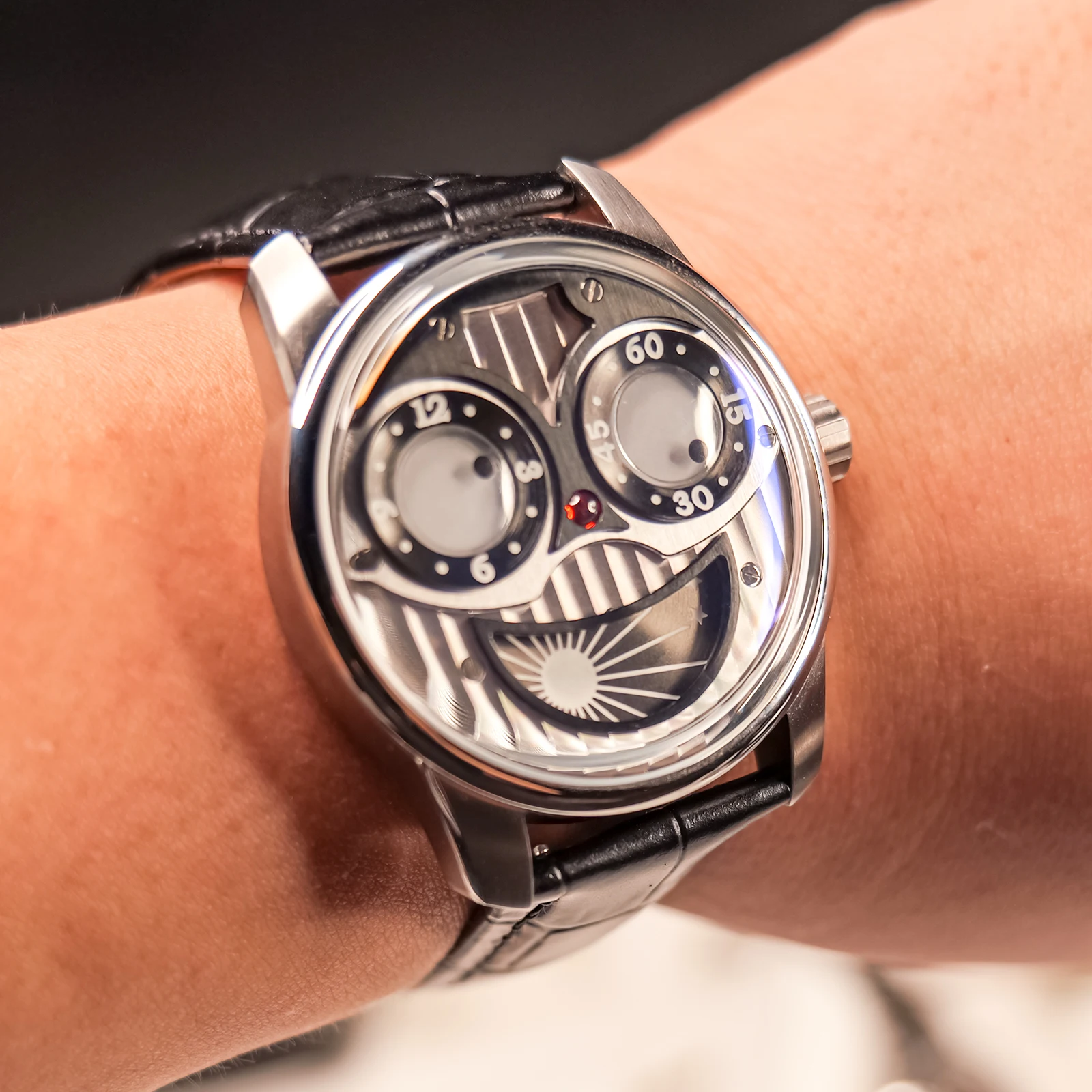
The Escapement
The escapement serves as the regulating heart of any mechanical watch, controlling the release of energy from the mainspring and maintaining consistent timekeeping. In skeleton designs, watchmakers take special care to expose this critical system, particularly highlighting the escape wheel and pallet fork.
This visibility enhances appreciation for the distinctive “tick-tock” rhythm of mechanical watches. With each oscillation of the balance wheel, the pallet fork engages and disengages with the escape wheel in a precisely choreographed dance. This perpetual motion represents the literal heartbeat of the timepiece—a visual rhythm that many collectors find deeply captivating.
The Balance Assembly
The balance assembly commands special attention in skeleton watches, often positioned prominently as the visual centerpiece of the design. This oscillating wheel, regulated by a hairspring, beats several times per second (typically 28,800 vibrations per hour in modern watches), setting the pace for the entire movement.
The continuous back-and-forth motion of the balance wheel creates visual dynamism unmatched by any other component. This hypnotic oscillation serves as a constant reminder that a skeleton watch is not merely an object but a living mechanical ecosystem with its own rhythm and pulse.
The Winding Mechanism
Automatic skeleton watches present unique opportunities for visual drama through their self-winding systems. Unlike manual movements that require daily winding, automatic calibers harness the natural motion of the wearer’s wrist to maintain power. The skeletonized rotor—often decorated with intricate patterns—swings freely with wrist movement, visibly transferring energy to the mainspring.
The interaction between the winding mechanism and other components creates a fascinating dynamic as energy flows from the rotor through the winding gears and into the mainspring barrel. This visual representation of energy capture and storage adds another dimension to the horological display.
Beyond Function: The Artistic Finishing of Exposed Components
In skeleton watchmaking, the functional components become the visual canvas, demanding finishing techniques that elevate raw metal to art. These finishes serve dual purposes—enhancing aesthetic beauty while improving durability and performance through reduced friction and increased corrosion resistance.
Anglage (chamfering or beveling) represents perhaps the most distinctive finishing technique in fine watchmaking. This process creates polished angles along component edges, transforming sharp 90-degree corners into smooth, mirror-polished surfaces that catch and reflect light. Traditionally performed by hand with specialized files and polishing tools, proper anglage can require hours of work on a single small component.
The surfaces of skeleton watch parts undergo various polishing treatments that create a spectrum of visual textures. Some components receive mirror polishing so perfect they appear almost liquid, while others might feature matte or brushed finishes that reduce glare and create visual contrast. This interplay of textures adds tremendous depth to the movement’s appearance.
Many high-end skeleton watches feature hand-engraving that transforms structural components into miniature artistic canvases. Master engravers carve intricate patterns, floral motifs, or even miniature scenes onto bridges and plates, adding a layer of personalization and artistic expression that transcends pure mechanics. The longevity of automatic watches is often matched by these enduring artistic touches that maintain their beauty for generations.
Surface decorations provide another dimension of visual interest. Circular graining (perlage) creates overlapping circular patterns resembling fish scales. Côtes de Genève produces parallel wave-like stripes across larger surfaces. Sunburst finishing radiates outward from a central point, creating a dynamic starburst effect. Each technique requires specialized tools and considerable skill to execute properly.
Color elements add the final touch of visual drama. Heat-blued screws—created by carefully heating steel to a precise temperature—provide striking sapphire-like accents. Rhodium plating adds brilliant silver tones to brass components, while gold plating introduces warm highlights. These color elements create essential visual contrast against the mechanical background.
When properly executed, these finishing techniques transform a functional mechanism into a three-dimensional artistic composition. Light plays across the varying surfaces, creating a dynamic visual experience that changes with every movement of the wrist. The hundreds of hours of handwork involved in fine finishing explain why truly exceptional skeleton watches command premium prices and hold their value over time.
Crystal Clear: The Role of Transparent Materials
The beauty of a skeleton movement would remain hidden without equally transparent enclosures. Sapphire crystal stands as the premium solution for this critical role, offering unmatched optical clarity and durability. With a Mohs hardness rating of 9 (second only to diamond), sapphire resists scratches from nearly all everyday materials, ensuring the view of the movement remains pristine year after year.
Strategic placement of transparent elements maximizes the visual impact of skeleton design. The most basic implementation replaces the traditional dial with a sapphire crystal disc, often minimally printed with hour markers to avoid obscuring the movement below. Exhibition case backs provide a window to the reverse side, creating a complete view of the mechanical ecosystem within. The most advanced designs incorporate transparent sapphire bridges and mainplates, allowing light to pass completely through the movement for unprecedented visibility.
These transparent elements transform the watch from a flat visual experience into a three-dimensional mechanical diorama. Light enters from multiple angles, creating depth through shadows and highlights that reveal the layered architecture of the movement. This sense of depth distinguishes exceptional skeleton watches from their more conventional counterparts.
The incorporation of sapphire components presents significant technical challenges. Although extremely hard, sapphire is also brittle and requires specialized cutting and polishing techniques. The material must be grown in synthetic cylindrical boules, then cut, shaped, and polished using diamond tools—a process that can take days for complex components. The engineering behind slim watch movements becomes even more impressive when incorporating these transparent elements while maintaining structural integrity.

Visual Symphony: The Aesthetic Appeal of Mechanical Transparency
The enduring fascination with skeleton watches stems from a fundamental human curiosity about how things work. There’s something profoundly satisfying about seeing the direct mechanical relationship between the winding crown, mainspring, gear train, and hands—a visual explanation of cause and effect that digital devices simply cannot provide.
The hypnotic rhythm of a skeleton watch’s oscillating components creates a uniquely meditative visual experience. The balance wheel’s steady oscillation, the smooth rotation of gear wheels, and the periodic release of the escapement combine in a mechanical ballet that measures the passing seconds. This visual rhythm makes time itself visible in a way that connects the wearer to the fundamental physics of timekeeping.
A skeleton watch transforms the experience of checking the time from a mere glance at static hands into an engagement with a living mechanical ecosystem. This enhanced connection between wearer and timepiece transcends the watch’s utilitarian purpose, transforming it into kinetic wrist art that tells a story of mechanical ingenuity and human creativity.
The transparency of skeleton watches creates a multi-sensory experience. Beyond the visual drama, the removed material often makes the mechanical sounds more audible—the gentle ticking becomes both a sound and a sight as the wearer can simultaneously hear and see the escapement in action. This synchronized sensory experience deepens the connection between wearer and watch.
On an intellectual level, skeleton watches invite appreciation of engineering excellence. Each visible component represents centuries of horological development refined to its essential purpose. The skeleton watch thus becomes not merely a timekeeping tool but a wearable celebration of human ingenuity and problem-solving expressed through mechanical art.
Stylistic Spectrum: Modern Approaches to Movement Exposure
The world of skeleton watches encompasses a diverse range of aesthetic approaches, each offering a different interpretation of mechanical transparency.
Traditional full skeletonization follows classical principles established over centuries of watchmaking. These designs typically feature extensively hand-finished components with elaborate hand-engraving on remaining bridges. The aesthetic leans toward ornate detailing, with flowing curves and organic shapes reminiscent of 19th-century pocket watches. The emphasis remains on showcasing traditional craftsmanship with maximum material removal.
Contemporary architectural skeletonization represents a modern reinterpretation of the art form. These designs embrace geometric precision with angular bridges, minimalist structures, and industrial-inspired aesthetics. Rather than removing maximum material, this approach focuses on creating visually striking structures that frame the mechanical elements. The movement becomes a miniature feat of architectural engineering, often incorporating straight lines, sharp angles, and asymmetrical layouts.
Open heart automatic watches offer a more restrained approach to movement visibility. Rather than exposing the entire mechanism, these designs feature strategic windows that reveal only the most dynamic components—typically the balance wheel and escapement. This partial revelation creates a focused visual highlight while maintaining more traditional dial aesthetics around the periphery.
The evolution of watchmaking technology has introduced avant-garde materials that further enhance skeleton aesthetics. Modern designs increasingly incorporate sapphire bridges, silicon components, and composite materials that were unavailable to previous generations. These non-traditional materials enable new structural possibilities while offering distinctive visual properties like complete transparency or unique colors.
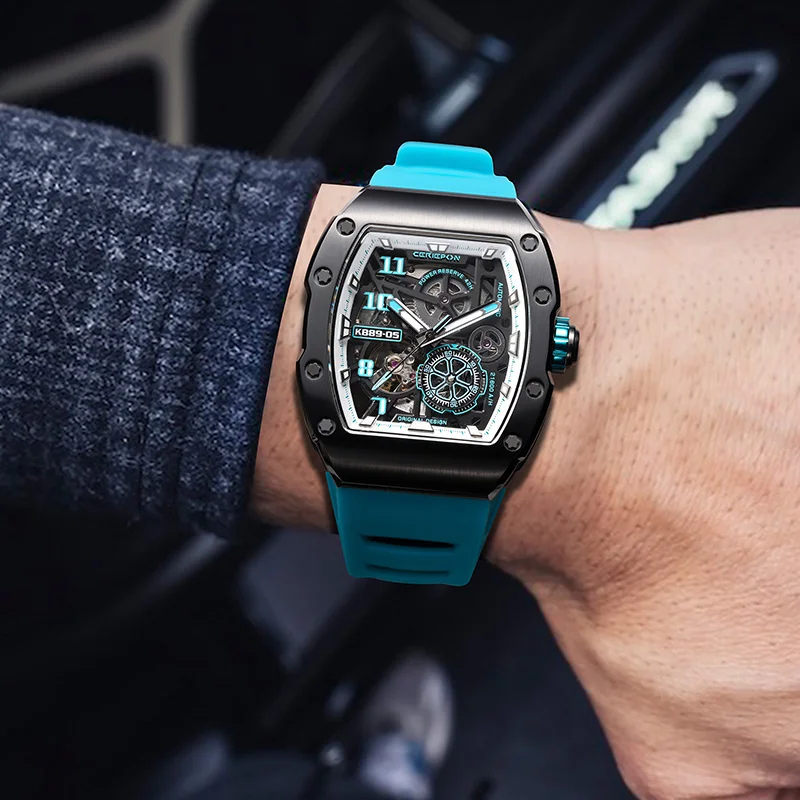
Different manufacturers have developed signature styles in their approach to movement exposure. Some emphasize traditional hand-finishing and classical proportions, while others push boundaries with futuristic architecture and high-tech materials. These distinctive house styles allow brands to express their horological philosophy through the medium of skeletonization.
The evolution of skeleton aesthetics continues in contemporary watchmaking, with each new generation of designers finding fresh interpretations of this centuries-old art form. Today’s skeleton watches range from historically-inspired pieces that honor traditional techniques to boundary-pushing designs that reimagine the very concept of how a mechanical watch can look and function.
Automatic Skeleton Watches, Open Heart Automatic Watches
$98.36 Select options This product has multiple variants. The options may be chosen on the product pageBlack Skeleton Watches, Mechanical Skeleton Watches
Price range: $37.40 through $111.92 Select options This product has multiple variants. The options may be chosen on the product pageAutomatic Skeleton Watches, Mechanical Skeleton Watches
Price range: $166.16 through $169.76 Select options This product has multiple variants. The options may be chosen on the product pageAutomatic Skeleton Watches, Military Inspired Automatic Watches, Unique Automatic Watches
$191.88 Select options This product has multiple variants. The options may be chosen on the product pageAutomatic Skeleton Watches, Unique Automatic Watches
Price range: $1,718.05 through $1,749.20 Select options This product has multiple variants. The options may be chosen on the product pageAutomatic Skeleton Watches, Classic Automatic Dress Watches
Price range: $139.40 through $155.48 Select options This product has multiple variants. The options may be chosen on the product page
Is a Skeleton Watch Right for You? Practical Considerations
Are skeleton watches more fragile than regular timepieces?
While the removed material might suggest increased fragility, properly executed skeleton watches maintain structural integrity through careful engineering. The remaining components are designed to preserve rigidity where needed. However, the exposed nature of the movement may make it more susceptible to dust or moisture in extreme conditions. Black skeleton watches with PVD coatings often provide additional protection against everyday wear.
Does skeletonization affect accuracy or reliability?
When executed by reputable manufacturers, skeletonization should not significantly impact performance. High-quality skeleton watches undergo the same stringent timing tests as their conventional counterparts. That said, the reduced mass of components may theoretically make some movements slightly more susceptible to positional variation or shock. In practice, this difference is minimal in well-engineered timepieces.
How does maintenance differ for skeleton watches?
Exposed movements benefit from slightly more frequent service intervals, as dust can more readily accumulate on visible components. The intricate finishing on skeleton components can also make servicing more specialized, potentially increasing maintenance costs. However, these considerations are offset by the owner’s ability to visually monitor the movement’s condition.
Are skeleton watches suitable for daily wear?
Many contemporary skeleton watches are designed with daily use in mind, featuring robust cases and adequate water resistance. For those seeking a skeleton watch for everyday wear, models with sapphire crystals on both front and back provide excellent protection while maintaining visibility. Consider your typical activities when selecting the appropriate level of durability for your needs.
The Art of Seeing Time: Why Mechanical Revelation Endures
The enduring fascination with skeleton watches transcends horological trends, speaking to a fundamental human appreciation for craftsmanship made visible. In an age of digital black boxes whose inner workings remain mysterious, the mechanical transparency of skeleton watches offers a refreshing counter-narrative—celebrating rather than concealing the engineering that makes these timepieces function.
These watches represent the perfect synthesis of art and engineering. Each component serves both a mechanical purpose and an aesthetic one, existing at the intersection of function and beauty. This dual nature elevates the skeleton watch beyond mere timekeeping instrument to become a philosophical statement about the value of understanding the mechanisms that govern our lives.
The skeleton watch serves as a celebration of the watchmaker’s skill and vision. By deliberately exposing the movement to scrutiny, the creator makes a bold statement of confidence in their craftsmanship. Every component must not only function perfectly but also be finished to withstand close examination—a standard that pushes watchmaking to its highest expression.
As objects of both technical precision and artistic expression, skeleton watches continue to captivate new generations of enthusiasts. They remind us that in a world increasingly dominated by digital abstraction, there remains profound beauty in mechanical systems that translate physical forces into the measurement of time—a dance of gears and springs that has fascinated humanity for centuries and shows no signs of losing its appeal.

